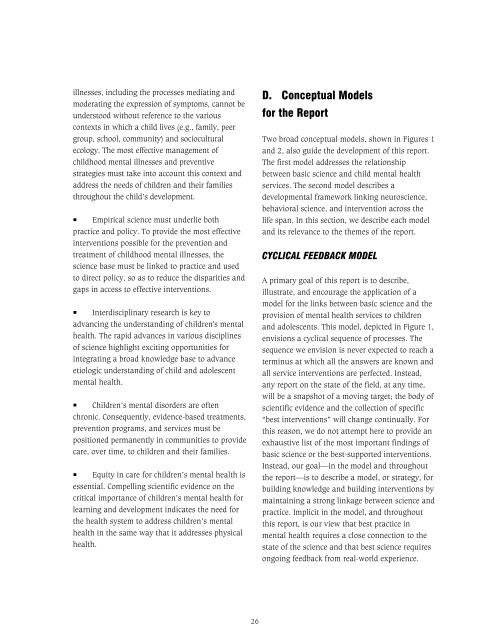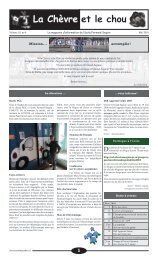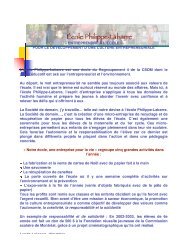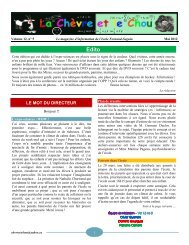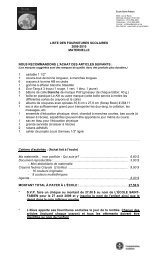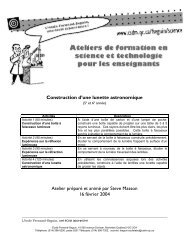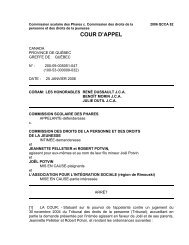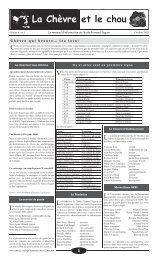Research on Child and Adolescent Mental Health
Research on Child and Adolescent Mental Health
Research on Child and Adolescent Mental Health
You also want an ePaper? Increase the reach of your titles
YUMPU automatically turns print PDFs into web optimized ePapers that Google loves.
illnesses, including the processes mediating <strong>and</strong><br />
moderating the expressi<strong>on</strong> of symptoms, cannot be<br />
understood without reference to the various<br />
c<strong>on</strong>texts in which a child lives (e.g., family, peer<br />
group, school, community) <strong>and</strong> sociocultural<br />
ecology. The most effective management of<br />
childhood mental illnesses <strong>and</strong> preventive<br />
strategies must take into account this c<strong>on</strong>text <strong>and</strong><br />
address the needs of children <strong>and</strong> their families<br />
throughout the child’s development.<br />
P Empirical science must underlie both<br />
practice <strong>and</strong> policy. To provide the most effective<br />
interventi<strong>on</strong>s possible for the preventi<strong>on</strong> <strong>and</strong><br />
treatment of childhood mental illnesses, the<br />
science base must be linked to practice <strong>and</strong> used<br />
to direct policy, so as to reduce the disparities <strong>and</strong><br />
gaps in access to effective interventi<strong>on</strong>s.<br />
P Interdisciplinary research is key to<br />
advancing the underst<strong>and</strong>ing of children's mental<br />
health. The rapid advances in various disciplines<br />
of science highlight exciting opportunities for<br />
integrating a broad knowledge base to advance<br />
etiologic underst<strong>and</strong>ing of child <strong>and</strong> adolescent<br />
mental health.<br />
P <strong>Child</strong>ren’s mental disorders are often<br />
chr<strong>on</strong>ic. C<strong>on</strong>sequently, evidence-based treatments,<br />
preventi<strong>on</strong> programs, <strong>and</strong> services must be<br />
positi<strong>on</strong>ed permanently in communities to provide<br />
care, over time, to children <strong>and</strong> their families.<br />
P Equity in care for children’s mental health is<br />
essential. Compelling scientific evidence <strong>on</strong> the<br />
critical importance of children’s mental health for<br />
learning <strong>and</strong> development indicates the need for<br />
the health system to address children’s mental<br />
health in the same way that it addresses physical<br />
health.<br />
D. C<strong>on</strong>ceptual Models<br />
for the Report<br />
Two broad c<strong>on</strong>ceptual models, shown in Figures 1<br />
<strong>and</strong> 2, also guide the development of this report.<br />
The first model addresses the relati<strong>on</strong>ship<br />
between basic science <strong>and</strong> child mental health<br />
services. The sec<strong>on</strong>d model describes a<br />
developmental framework linking neuroscience,<br />
behavioral science, <strong>and</strong> interventi<strong>on</strong> across the<br />
life span. In this secti<strong>on</strong>, we describe each model<br />
<strong>and</strong> its relevance to the themes of the report.<br />
CYCLICAL FEEDBACK MODEL<br />
A primary goal of this report is to describe,<br />
illustrate, <strong>and</strong> encourage the applicati<strong>on</strong> of a<br />
model for the links between basic science <strong>and</strong> the<br />
provisi<strong>on</strong> of mental health services to children<br />
<strong>and</strong> adolescents. This model, depicted in Figure 1,<br />
envisi<strong>on</strong>s a cyclical sequence of processes. The<br />
sequence we envisi<strong>on</strong> is never expected to reach a<br />
terminus at which all the answers are known <strong>and</strong><br />
all service interventi<strong>on</strong>s are perfected. Instead,<br />
any report <strong>on</strong> the state of the field, at any time,<br />
will be a snapshot of a moving target; the body of<br />
scientific evidence <strong>and</strong> the collecti<strong>on</strong> of specific<br />
“best interventi<strong>on</strong>s” will change c<strong>on</strong>tinually. For<br />
this reas<strong>on</strong>, we do not attempt here to provide an<br />
exhaustive list of the most important findings of<br />
basic science or the best-supported interventi<strong>on</strong>s.<br />
Instead, our goal—in the model <strong>and</strong> throughout<br />
the report—is to describe a model, or strategy, for<br />
building knowledge <strong>and</strong> building interventi<strong>on</strong>s by<br />
maintaining a str<strong>on</strong>g linkage between science <strong>and</strong><br />
practice. Implicit in the model, <strong>and</strong> throughout<br />
this report, is our view that best practice in<br />
mental health requires a close c<strong>on</strong>necti<strong>on</strong> to the<br />
state of the science <strong>and</strong> that best science requires<br />
<strong>on</strong>going feedback from real-world experience.<br />
26


